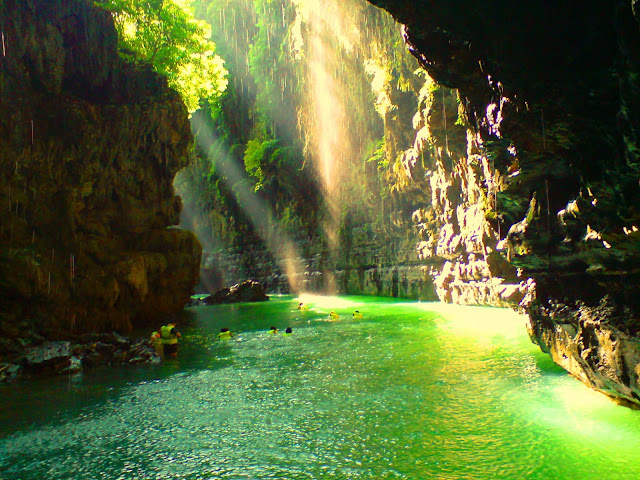Wakatobi National Park is one of 50 parks nasoinal in Indonesia, located in the district Wakatobi, Southeast Sulawesi. This national park is set in 2002, with a total area of 1.39 million ha, concerning marine biodiversity, scale and condition of coral; which occupies one of the highest priority position of marine conservation in Indonesia. The depth of water in the park is varied, the deepest part reaches 1,044 meters below sea level.
Wakatobi become one of the national park that has the beauty of the underwater world that is no less great than the Raja Ampat and Bunaken. For those of you who like diving, you should obligatory visit Wakatobi. Waktobi located in Southeast Sulawesi province.
In this park there is a panoramic view of the beauty of the underwater world that has 25 pieces of coral reef. Coral reefs can be found around 112 species of 13 families located at 25 points along the 600 km coastline.

In this park there is a panoramic view of the beauty of the underwater world that has 25 pieces of coral reef. Coral reefs can be found around 112 species of 13 families located at 25 points along the 600 km coastline.

In addition to the beauty that is presented by a wide range of coral reefs, the park also has a variety of fish species. Fish species richness of this national park which is owned as many as 93 species of fish and ornamental fish trade consumption. For tourists who love the beauty of the underwater world can do some activities in Wakatobi National Park, such as diving, snorkeling and swimming to see the beautiful coral reefs and a variety of underwater animals and also witnessed various local culture.
The beauty and richness of Wakatobi National Park area is already well known in foreign countries, especially after Wallacea expedition from England in 1995 which states that the area in Southeast Sulawesi is very rich in species of coral. There, there are 750 of the total 850 species of coral in the world. Configuration depth varies from flat to sloping to the sea and in some areas there are bertubir steep waters. The deepest part of the waters reaches 1,044 meters.
More than 112 species of coral from 13 families can be found in Wakatobi, including: Acropora formosa, A. Hyacinthus, Psammocora profundasafla, Pavona cactus, Leptoseris yabei, Fungia molucensis, Lobophyllia robusta, Merulina ampliata, Platygyra versifora, Euphyllia glabrescens, Tubastraea frondes , Stylophora pistillata, Sarcophyton throchelliophorum, and Sinularia spp who live in harmony with other underwater inhabitants.
Fish species richness owned this national park as many as 93 species of fish such (Cephalopholus argus), takhasang (Naso unicornis), pogo-pogo (Balistoides viridescens), napoleon (Cheilinus undulatus), perch (Lutjanus biguttatus), rabbitfish (Siganus guttatus) , Amphiprion melanopus, Chaetodon specullum, Chelmon rostratus, Heniochus acuminatus, Lutjanus monostigma, Caesio caerularea, and others.
Wakatobi National Park is also home to several species of sea birds such as geese-Stones Brown (Sula leucogaster plotus), Malay plover (Charadrius peronii) and Eurasian kingfisher (Alcedo atthis) nesting. Several species of sea turtles also make this park their home such as the hawksbill turtle (Eretmochelys imbricata), loggerhead (Caretta caretta) and Olive Ridley turtles (Lepidochelys olivacea).
Wakatobi waters have loyal guests who make Wakatobi waters as a playground, the guest was none other than the sperm whale (Physeter macrocephalus). Typically, sperm whales are in Wakatobi in November, while the other hemisphere frozen. In the relatively warmer Wakatobi waters and abundant food that can satiate the stomach whales. Not only that Wakatobi is also a playground manta ray (Manta ray) are classified as giant body size. Mantas is one type of fish that is distinctive and unique, which is only found in tropical waters.
Wakatobi formation began in the tertiary era until the end of the Miocene age as a result of geological processes in the form of a sliding fault that can not be separated from the operation of tectonic style. Overall this archipelago consists of 39 islands, three charred and 5 atolls. Of the process of formation, in contrast to the atoll in Wakatobi atolls located in other areas. Atoll in this area is formed by the presence of the sinking of the base plate. Some atolls are visible now, among other things Kaledupa Atoll, Kaafu kapota and Tomia Atoll.
Wakatobi waters are at the "Coral Tri-Angle" or the coral triangle region, ie the region which has a diversity of coral reefs and other marine highest biodiversity in the world, including the Philippines, Indonesia to Solomon Islands. The existence of 25 pieces of coral reef and makes the ideal depth waters in the Park an ideal place for many species of marine life to live, making sea dwellers here have aesthetic value and high conservation.
Specifically the Park surrounded by beaches of coral islands along the 600 km and beach destination with huge potential to be managed, scattered throughout the Wakatobi region. So it was not without reason that the beach area in Wakatobi is perfect for sightseeing as diving, snorkeling, swimming and fishing.
















































